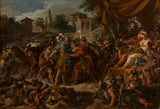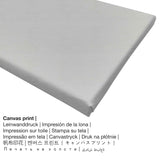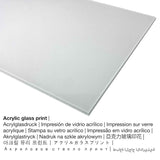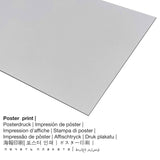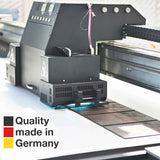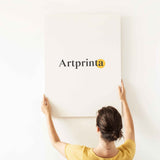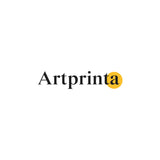Jean-François de Troy, 1742 - Ọgụ ndị agha mụrụ site na ezé agwọ - ọmarịcha nka.
Ụtụ gụnyere. Mbupu gbakọrọ na ndenye ọpụpụ.
Họrọ ngwa ngwaahịa ịchọrọ ịnwe
Na menu ndọpụta na-esote isiokwu ị nwere ike họrọ ihe na nha nke nhọrọ gị. Anyị na-ahapụ gị ka ịhọrọ nha na akụrụngwa ọkacha mmasị gị n'etiti nhọrọ nhazi ngwaahịa ndị a:
- Mpempe akwụkwọ (ihe kwaaji): The poster print is a UV printed flat canvas paper with a slightly rough surface finish. The printed poster is qualified for placing your art print with the help of a special frame. Please keep in mind, that depending on the size of the poster print we add a white margin of around 2-6cm round about the work of art in order to facilitate the framing.
- Mbipụta kanvas: A printed canvas, which should not be mistaken with a painting on a canvas, is a digital replica applied directly on canvas material. Hanging a canvas print: Canvas prints are relatively low in weight, meaning that it is quite simple to hang up the Canvas print without the use of extra wall-mounts. Canvas prints are suited for all types of walls in your house.
- Mbipụta iko acrylic (nke nwere ezigbo mkpuchi iko): The print on acrylic glass, which is often described as a print on plexiglass, changes your favorite original artwork into wall decoration. Moreover, the acrylic glass art print offers a distinct alternative option to canvas or aluminium dibond fine art prints. The artwork is custom-made with modern UV direct printing machines. This makes vibrant and deep colors. The great upside of an acrylic glass print is that contrasts plus image details become visible with the help of the fine tonal gradation.
- Mbipụta ọla (aluminium dibbond): An Aluminium Dibond print is a print with a true depth effect - for a modern impression and non-reflective surface structure. The bright & white parts of the artwork shine with a silky gloss, however without the glare. The colors are luminous and bright in the highest definition, the fine details are very clear.
Ederede iwu dị mkpa: We try what we can in order to describe our products as closely as possible and to showcase them visually on the various product detail pages. Nevertheless, the tone of the printing material and the print result may diverge to a certain extent from the image on your device's screen. Depending on the screen settings and the nature of the surface, color pigments might not be printed as realisitcally as the digital version depicted here. Because all our art reproductions are processed and printed manually, there may also be minor deviations in the motif's exact position and the size.
Additional specifications as provided by Petit Palais - Musée des Beaux-arts de la Ville de Paris (© Nwebiisinka - Petit Palais - Musée des Beaux-arts de la Ville de Paris - www.petitpalais.paris.fr)
The dragon of Thebes is mentioned in the Argonautica of Apollonius of Rhodes. These are his teeth, gift of the goddess Athena, whom the king of Colchis, Aeetes ordered Jason to plant in order to experience it. As Cadmus to Thebes, he left the land sown teeth of the monstrous snake, an army of soldiers.
Argonauts (Greek mythology); Jason (Greek mythology); Medea (Greek mythology)
mythological scene, Greco-Roman mythology, golden fleece, hero - heroine, Fighting Soldier, Dragon, Ox
Ihe karịrị 270 years old artwork was painted by the painter Jean-François de Troy na 1742. The 270 year-old version of the piece of art was made with the size of Height: 55,5 cm, Width: 80,5 cm. Mmanụ, Canvas (ihe) was applied by the painter as the technique for the masterpiece. Furthermore, the artpiece can be viewed in in the art collection of Petit Palais - Musée des Beaux-arts de la Ville de Paris, nke bụ ihe ngosi nka nka na mpaghara 8th. Site n'ikike nke - Petit Palais Paris (public domain).The creditline of the artwork is the following: . Besides this, the alignment is odida obodo na akụkụ ruru nke 3: 2, nke pụtara na ogologo bụ 50% ogologo karịa obosara.
Iberibe tebụl nka
| Aha eserese: | "Combat soldiers born of snake teeth" |
| Nhazi nka nka: | sere |
| Category: | nka ochie |
| Nhazi oge: | 18th narị afọ |
| Afọ nka: | 1742 |
| Afọ nka: | karịa afọ 270 |
| Usoro nka izizi: | Mmanụ, Canvas (ihe) |
| Ogo nke ọrụ nka izizi: | Ogologo: 55,5 cm, obosara: 80,5 cm |
| Egosiputara na: | Petit Palais - Musée des Beaux-arts de la Ville de Paris |
| Ebe ebe ngosi nka: | Paris, France |
| Ibe weebụ: | Petit Palais - Musée des Beaux-arts de la Ville de Paris |
| Ụdị ikike nka: | ngalaba ọha |
| Site n'aka: | Petit Palais Paris |
Nkọwa akụkọ ahaziri ahazi
| Bipụta ụdị ngwaahịa: | ọmarịcha nka |
| Mmeputakwa: | mmeputakwa n'ụdị dijitalụ |
| Usoro mmepụta: | mbipụta dijitalụ (Mbipụta UV ozugbo) |
| Ihe ngosi: | arụpụtara na Germany |
| Stockdị ngwaahịa: | a na-achọ |
| A na-atụ aro iji ngwaahịa eme ihe: | nchịkọta nka (mmeputakwa), ụlọ mmepụta nka nka |
| Nhazi onyonyo: | nhazi odida obodo |
| Ụdị anya: | 3: 2 |
| Nsonaazụ: | ogologo bụ 50% ogologo karịa obosara |
| Ụdị ngwaahịa dị iche iche: | mbipụta akwụkwọ mmado (akwụkwọ kwaaji), mbipụta kanvas, mbipụta enyo acrylic (nwere ezigbo mkpuchi iko), mbipụta ọla (aluminium dibbond) |
| Nhọrọ nha nha mbipụta kanvas (akwa akwa na etiti ihe ndọtị): | 30x20cm - 12x8", 60x40cm - 24x16", 90x60cm - 35x24", 120x80cm - 47x31", 150x100cm - 59x39" |
| Acrylic glass print (nwere ezigbo mkpuchi iko) nhọrọ: | 30x20cm - 12x8", 60x40cm - 24x16", 90x60cm - 35x24", 120x80cm - 47x31" |
| Nhọrọ nke mbipụta akwụkwọ mmado (akwụkwọ kwaaji): | 60x40cm - 24x16", 90x60cm - 35x24", 120x80cm - 47x31" |
| Ụdị mbipụta aluminom dibond: | 30x20cm - 12x8", 60x40cm - 24x16", 90x60cm - 35x24", 120x80cm - 47x31" |
| ụba: | adịghị |
Nchịkọta ihe nkiri
| aha: | Jean-François de Troy |
| Ọrụ onye na-ese ihe: | onye na-ese ihe |
| Nkewa onye nka: | nna ukwu ochie |
| Nwụrụ na afọ nke: | 73 afọ |
| Afọ ọmụmụ: | 1679 |
| Amụrụ na (ebe): | Paris |
| Afọ nwụrụ: | 1752 |
| Nwuru na (ebe): | Rome |
© Nwebiisinka nke, www.artprinta.com (Artprinta)

